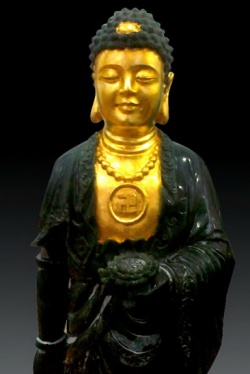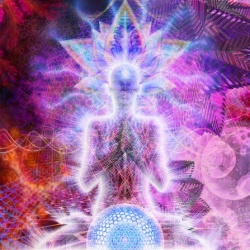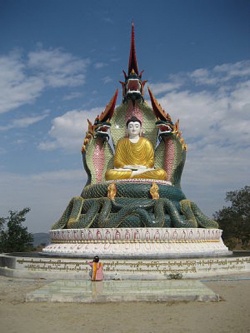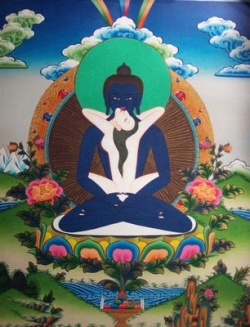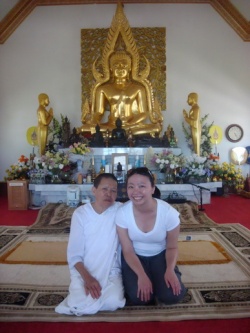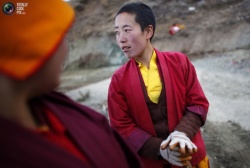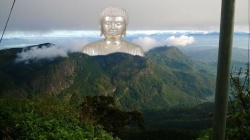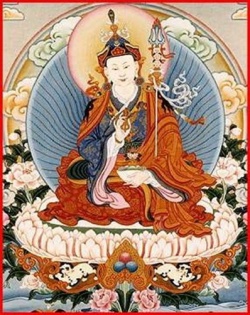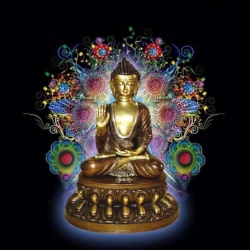On Conversation between Deleuzians and Buddhists by Professor Ian Cook
On Conversation between Deleuzians and Buddhists
Professor Ian Cook, Murdoch University, Australia
This paper begins with an extended discussion of its origins, so I shall not start by explaining its potential significance. Instead, I will focus on its significance for me. Many of those hearing or reading this paper will not identify with me and my values. I am not sure whether this paper has any significance for those listeners and readers. I will endeavour to specify my values as early as possible to save reading time; for those listening I cannot offer much. I had various ambitions for the paper; all of them were abandoned at various points in its development. I am left with a series of observations and questions and a few potential points of conversations between some Buddhists and some Deleuzians. In the end, that was all I concerned myself with and not with what they might agree upon. Before I looked for agreement, I told myself, perhaps I should look for the possibility of a conversation.
I encountered Deleuze’s works many year ago, but Foucault’s, and to a lesser extent, Derrida’s were more important to me. Here are a couple of biographical entries on Deleuze and Guattari:
- “Gilles Deleuze (January 18, 1925–November 4, 1995) was one of the most influential and prolific French philosophers of the second half of the twentieth century. Deleuze conceived of philosophy as the production of concepts, and he characterized himself as a “pure metaphysician.” … In 1968, he met Félix Guattari, a political activist and radical psychoanalyst, with whom he wrote several works.” The Stanford Encyclopedia of Philosophy http://plato.stanford.edu/entries/deleuze/
- “Félix Guattari (April 30, 1930-August 29, 1992) was a political activist and anti-psychiatrist. … Guattari defied any professional categorization as ‘he cultivated a bemused distance from [these diverse fields], usually through asking deceptively simple questions about why such human activities exist and what their purpose may be.’... Internationally …Guattari’s celebrity comes from his collaboration with Gilles Deleuze. However in France, his celebrity arose from his anti-establishment medical, social and political stances.” The European Graduate School http://www.egs.edu/library/felix-guattari/biography/
Many years after I first encountered Deleuze and Guattari’s works, I began to teach students to look at politics from a post-modern or post-structuralist perspective and this meant that I returned to Deleuze and Guattari. Both worked in a French intellectual tradition that was heavily influenced by Freudian psychology and Marxist theory, which makes their work familiar to me. But Deleuze, in particular, added many other philosophies much less familiar, and yet somehow interesting to me. One of my postgraduate students wrote a thesis using Deleuze’s works and those he wrote with Guattari. Sometime later, toward the end of 2011, another member of staff at my university suggested we co-author a piece on Deleuze’s Postscript on the Societies of Control. Seven articles and four conference papers later, we continue to find much value in Deleuze and Guattari’s works.
Apart from thinking of human beings as basically communicative animals, I decided not to assume that a conversation between Buddhists and Deleuzians was either necessary or desirable. I assumed that most Buddhist’s carry simple human desire to converse (even those who so often choose to stay silent. The point I’d like to note here is that I have tried to consider the possibilities around conversation from the perspectives of both parties to the conversation. My knowledge of Buddhism is limited, very limited in comparison to most listeners and readers of this paper. I meditate most days. I’m not sure what success is, but I am pretty sure that I don’t achieve it. That’s OK, however, as it is now a habit to sit still each morning. I do not employ visualisations and seek, in the end, to ‘just sit. And I fail. I was introduced to Buddhism through the works of D.T. Suzuki, so it has always been very much a Western Buddhism. I enjoy works that address the application of Buddhist principles to daily modern western life and have found great inspiration and assistance in the works of Pema Chodron. She is a teacher with Shambhala http://www.shambhala.org/. Her biography on this site contains the following: ““Pema Chodron is a leading exponent of teachings on meditation and how they apply to everyday life. She is widely known for her charming and down-to-earth interpretation of Tibetan Buddhism for Western audiences. Pema is the resident teacher at Gampo Abbey, Cape Breton, Nova Scotia, the first Tibetan monastery for Westerners and has authored several books..”. I have studied some of the sutras and read some of the Pali cannon, but it has always been something I studied in addition to all the other things I was studying. I like to study.
I teach politics. I was trained in political theory. Politics is about many things, but it is definitely about power and its use. It concerns the organisation of society. One of the practices that I engage in as a political theorist I refer to as traditional political theory. (For a full description of traditional political theory, see my book Reading Mill, which was based on my PhD thesis.) In traditional political theory, a theorist sees him or herself as embedded in a timeless conversation concerning three principal questions: “What are people like?”, “What is the best life for them to lead?”, and “Which social arrangements result in conditions that maximise every person’s capacity to live well?”
The first question can otherwise be thought of as the question of human nature. Enquiries into what motivates and otherwise explains people’s actions have been undertaken for a very long time, ever since self-consciousness arose on this plane of existence. It is a question Buddhists ask too, so it seems to provide at least some basis for thinking that Buddhists and Deleuzians might have a useful conversation. The question of the good life, which is how we otherwise frame the second question, might also be understood as the question of living well and what it takes to live well. Once again, I see this as a question that Buddhists may well ask themselves. The third question, which can also be thought of as the question of the good society, is in many ways not a question that Buddhists need ask themselves.
Engaged Buddhism
The third question of traditional political theory, then, represents in many ways the first point at which Buddhists and Deleuzians may fall silent when in each other’s midst. For it is here that a Buddhist might assert (and, indeed, one asserted this to me at a previous conference) that they have some interest in the question of human nature and great interest in the question of living well, but no interest in the question of the good society. Well, no personal interest in this question. It might, this (imagined) Buddhist might concede, be a potentially important question for other people and of some relevance to them and their life. But in the end, I have been told, for some, at least, Buddhism is a personal practice.
I have no desire to challenge this view. I do not accept it for myself, for reasons that might become clear as this paper develops. For those who conceive of themselves as Buddhists, however, I draw attention to the philosophy of engaged Buddhism, as elaborated and practised by the Dalai Lama and Thich Nhat Hanh. I will take the opportunity to review, Sulak Sivaraksa, another engaged Buddhist’s, views concerning the necessity of practising an engaged form of Buddhism. I do so simply to provide a basis, from within Buddhism, for considering the question of the Buddhist’s responsibilities when it comes to the question of the good society. I offer these commentaries simply by way of providing a focus for this paper. I am not trying to convince anyone of anything (which is a point that applies more broadly to this paper).
Sulak Sivaraksa is a Thai, or as he’d prefer Siamese, Buddhist. He was seventy last year and for the last forty years has been a spokesperson for a variety of groups (NGOs) that have sometimes found themselves in a critical relationship to those in positions of political power. The groups with which he has been involved include the Pridi Banomyong Institute (named after one of the leaders of Thailand’s 1932 Pro-Democracy Coup), the Slum Childcare Foundation, the Co-ordinating Group for Religion and Society and the Thai Inter-Religious Commission for Development. Sivaraksa also co-founded the Asian Cultural Forum on Development and the International Network of Engaged Buddhists. He has found himself a target of political authorities on a number of occasions. He was forced out of Siam in 1976, arrested in 1894, and forced into political exile in 1991. (Anon)
Sulak Sivaraksa’s is a complex position. In advocating Engaged Buddhism he is not suggesting that Buddhists cease to devote themselves to personal enlightenment. Indeed, for him, Engaged Buddhism must begin with a commitment to address our own distance from Enlightenment. It does not end there, however. “We must be very demanding in transforming ourselves, but I think we would be deluded unless we also have clear understanding of how to change the oppressive society” (Sivaraksa, 2002, p. 43). This reflect Sivaraksa’s view that the “radical transformation of society requires personal and spiritual change first or at least simultaneously”, which means that “those who want to change society must understand the inner dimensions of change”. (Anon) This leads to the simple, but basic principle that “Buddhism teaches us that the transformation of society must first begin within the self.” (Sivaraksa, 2002, p. 41). But it does not end with the self. “As a Buddhist, if one is not radical and does not work to eliminate suffering, one may end up only taking a little bit of Buddhism for one’s individual ego.” (Sivaraksa, 2002, p. 42).
In making this point, Sivaraksa offers something of great value to all of those seeking social change, including Deleuzians, this is the insight that programs for social transformation that do not begin as projects of self-transformation of those who engage in them are doomed to repeat violences of the past.
We have more than enough programs, organisations, parties, and strategies in the world for the alleviation of suffering and injustice. In fact, we place too much faith in the power of action, especially political action. Social activism tends to preoccupy itself with the external. Like the secular intellectuals, activists tend to see all malevolence as being caused by ‘them’ - the ‘system’ - without understanding how these negative factors also operate within ourselves. They approach global problems with the mentality of social engineering, assuming that personal virtue will result from a radical restructuring of society. (Sivaraksa as quoted in (Anon))
As we will see later, these ideas are as useful to Deleuzians as they are to Buddhists; for it points to the centrality of self-transformation to social-transformation.
The relationship between personal and social transformation is complex for Sivaraksa, however. Practices of personal transformation results in the acquisition of a sense of “the power of mindfulness and the relationship between individual and collective wellbeing”. (Sivaraksa, 2002, p. 41). It is not by looking outward. “Realizing interconnectedness[, through meditation,] … we would then be moved to act with wisdom and compassion to end suffering and all forms of structural violence. This understanding about is very similar to the Buddhist perspective on the relationship between individual change and material development” (Sivaraksa, 2002, p. 41). For we come to realise that “spiritual considerations and social change cannot be separated.” And we realise this because we recognise that our personal transformation is performed in a social context. “Forces in our social environment, such as consumerism, with its emphasis on craving and dissatisfaction, can hinder our spiritual development. People seeking to live spiritually must be concerned with their social and physical environment.” (Sivaraksa as quoted in (Anon))
Buddhism, for Sivaraksa, has a three-fold idea of freedom. One aspect of freedom is “to be free some insecurities and the dangers of poverty, disease, famine, etc.. This level of freedom is the most influenced by advances in technology and health and global cooperation in the name of meeting basic needs, and is essential” (Sivaraksa, 2002, p. 42). Those suffering from starvation or exposure to the elements cannot learn to meditate. The second aspect of freedom is “the freedom from human oppression and exploitation… This stage of freedom synthesizes the collective with the individual in terms of peace and progress” (Sivaraksa, 2002, p. 42). The final aspect of freedom, “the freedom of the inner life”, seems to return to the personal. But this is not quite so, because this freedom is “the freedom from mental suffering, the freedom from insatiable desire, and the freedom to accept the cyclical, multicausal and inextricably connected nature of life” (Sivaraksa, 2002, p. 42). To simply focus inward is not enough. For this form of freedom “is not acquired merely through individual meditation and solitary reflection. Cooperation and compassion are both the means and the end.” (Sivaraksa, 2002, p. 42).
In developing his ideas, Sivaraksa is aware that he is revising Buddhism in important respects. He acknowledges that “Buddhist social ethics traditionally have been entirely personal.” He believes that revision is necessary because Buddhists have “not looked at the system which is violent, the system which is oppressive, the system, in fact, involves theft. The Buddhist notion of enlightenment and understanding (panna) also needs to be extended, so that enlightenment is not solely internal enlightenment; here also Buddhism has been weak” (Sivaraksa, 2002, p. 43) In part, this is simply to reflect the Buddha’s intention; for, “he intended to help liberate not only individuals, but the whole society” (Sivaraksa, 2002, p. 43). Revision is also necessary to maintain a role for Buddhism in a modern society. “Without transforming the Buddhist sense of wisdom to bring in understanding of and response to social reality, Buddhism will not be relevant and might only appeal to the middle class. If we are not careful, it will become a kind of escapism” (Sivaraksa, 2002, p. 43).
Conversations with Critical Theorists
It may well be that only some Buddhists, those practising engaged Buddhism, may have particular interest in conversations with Deleuzians, as the latter have their own agenda, and for many this involve changing society. In speaking with Deleuzians, should they choose to do so, Buddhists will find themselves engaging in a conversation with critical theorists. Critical theorists criticise society and the structures that hold it in place. Critical Theory began very much with the Marxist camp and remains close to it, but that camp has been largely dismantled and so critical theorists have departed from any strict Marxist position. Not too many Deleuzians write directly and consistently about ways to address social injustice, but their intellectual heritage means that this cannot be too far from mind and the position is always critical, always looking forward.
The classic statement of critical theory came from Max Horkheimer, who was a member of the so-called Frankfurt School. For Horkheimer, critical theory has as one of its main goals “the idea of a reasonable organization of society that will meet the needs of the whole community” (1975, p. 213). This view that by using our reason people can re-organise society is common to all critical theorists. “Unemployment, economic crises, militarization, terrorist regimes—in a word, the whole condition of the masses—are not due… to limited technological possibilities, as might have been the case in earlier periods, but to the circumstances of production which are no longer suitable to our time” (Horkheimer, 1975, p. 213). And the explanation for the problems in society is that the system of “production is not geared to the life of the whole community while heeding also the claims of individuals… This is the inevitable result… of the principle that it is enough for individuals to look out for themselves” (Horkheimer, 1975, p. 213).
So critical theorists seek social change and do so in favour of a form of social and economic organisation in which a more rational distribution of resources and responsibilities is achieved. Critical theorists, then, have an “eye to the aims and activities of those oppositional social movements with which it has a partisan though not uncritical identification. The questions it asks and the models it designs are informed by that identification and interest” (Fraser, 1985, p. 97). This quotation, from Nancy Fraser, is significant because Fraser was criticising critical theorists for not engaging effectively with the interests of women. Thus, for Fraser
the moral philosophical aspect of a critical theory develops a conception of justice, the social-theoretical aspect develops an understanding of capitalism, and the political aspect devises a practical orientation with the aim of emancipation. Specifically for Fraser, the moral-philosophical aspect clarifies that the single commitment presupposed by social movements and political actors is ‘participating on par with one another in social life’. Accordingly, Fraser develops the principle of parity of participation as the central norm of her conception of justice. (Zambrana, 2013, p. 106)
So it is not simply about addressing economic injustice but of providing for parity of participation, or trying to give equal voice to all those who suffer injustice.
But seeking social justice, if done properly, requires significant moments of self-reflection. In clarifying “the struggles of the present with the aim of contributing to dismantling systematic forms of domination,” Zambrana suggests, that they “must also pursue self-clarification. Theory is critical, Horkheimer famously argued, only if it is ‘self-aware’” (2013, p. 93). Critical theorists, then, are to attend “to the philosophical assumptions underlying critical-theoretical practices” (Zambrana, 2013, p. 94).
Self-reflection also requires taking things as they present themselves to be and examining them as they are, or in terms of their claims to be what they are. A central aspect of critical theory is the use of that they term immanent critique. Immanent critique involves assessing systems or situation in their own terms, or in terms of the values that are set out in justifying those systems. Critical theory “has always sought to develop an immanent form of critique in which critical standards are in some way drawn from ‘within’ the objects of criticism themselves, instead of being found elsewhere and then applied to them from ‘without’ as it were” (Trejo-Mathys, 2013, p. 459).
So, in talking to a Deleuzian, or indeed any critical theorist, a Buddhist need bear in mind the following. The critical theorist criticizes for the purposes of transformation or reorganisation. The critical theorist believes that the use of reason will help promote the reorganisation of society. The critical theorist once tended to focus exclusively on economic injustice, but now critical theorists are sensitive to a variety of forms of injustice. (This is not to say that there are not particular Deleuzian ‘takes’ on the character of and processes underpinning these injustices, however.) While many Deleuzians have lost sight of critical theory as the being at the root of their theoretical tradition, they retain a critical perspective and that ultimately leads to a concern with social, political and economic justice. Of course, only those who seek to practice and engaged form of Buddhism will find this important, but this paper has been written principally for the engaged Buddhist.
Why they might talk about: Conversation Starters
So now we have worked out something with respect to those engaged in the conversation let us try to work out whether there is anything to talk about. Please note that I feel no obligation to promote conversation. Silence can be as desirable a practice as speaking, as all Buddhists know. I have identified three concepts from Deleuze and Guattari’s thought as possible points of discussion, or conversation starters. These are desire partial objects and the Body without Organs. The elaboration of each of these concepts requires a discussion of psychoanalytic practice, and in particular the ways that Deleuze and Guattari reworked ideas from Sigmund Freud and. His most influential successor, Jacques Lacan. In interrogating the mind and its ideas of itself, however, Deleuze and Guattari believe that they are also interrogating bodily existence. They seek to create something, a recording surface, that might register both.
On the one hand, there is a surface formed at the interstices of material bodies; on the other hand, a surface of sense is embedded in language, allowing the proposition’s various functions – the designation of facts, the manifestation of a subject’s intentions, and the signification of universal concepts – to operate and ‘make sense’. ... Deleuze’s ultimate concern is a second-order surface where these surfaces of thought and thing intersect. (Widder, 2009, p. 211)
Desire
Desire is a concept that, to me anyway, seems interesting to both Buddhists and Deleuzians. The difference between the two is that Deleuzians are not so much trying to eliminate desire, as to reveal its historical socially contingent nature and to free it. It is by trapping us in particular desires that our society, in this case capitalism, ensures both productivity of the right sort and control. So, the most important thing to note about Deleuze and Guattari’s conception of desire is that they are not convinced that it is escapable. But, its inescapability has less to do with any basic human physiology and more to do with society. Specific desires, for them, are produced within societies. Deleuze and Guattari’s goal is to move beyond specific desires to free desire from a connection to any thing. I will look a little more closely at desires in the discussion of partial objects in the following section, for now it is simply important to note that specific desires are not something they see as essential to humanity. It is essential to society. But, while society’s processes are designed to bind us to the surface of this society, we can seek to escape the specific desires that are necessary for the reproduction of a particular society but engaging non-specific desire.
Deleuze and Guattari’s conception of desire must be understood as opposed to the view of desire as representing as lack, or as a relation to something missing. In adopting this view they directly oppose the position taken by Freud’s most influential follower: Jacques Lacan. This places them against the usual idea of desire as a manifestation of lack. “Lacan’s notion of desire is rather close to this everyday usage of the term insofar as it entails the absence or lack of the object of desire” (Lash, 1984, p. 8). It also places them against the Freudian-psychoanalytic understanding of desire as a permanent feature of the unconscious. For, while it conforms in some respects, Lacan’s concept diverges from our ordinary usage insofar as specifies that desire must be unconscious. Here the category dovetails with Freud’s concept of ‘wish’, which… is … seen as developing from a need that was satisfied in the past but not in the present; hence from a lack. Lacan distinguishes desire from ‘need’ and ‘demand’. The infant at first cannot distinguish need from demand. With separation from the mother and identification with the father, demand and need become distinct and desire is born. Demand is conscious, desire is unconscious. (Lash, 1984, p. 8)
Locating desire in the unconscious is important because it suggests that desire cannot be overcome by the proliferation of goods and services. If it is unconsciously produced, then it is to the processes of the unconscious that we need to direct our attention.
In other words, a desire for some particular thing is a mental event that occurs under specific historical conditions. Our society, then, lays traps of desire and we move through these traps in something we call a life. Living becomes jumping from one specific desire to the next specific desire, but beneath, through and over this runs non-specific desire; or, in other words, the desire for no thing. At the heart of all desire, then, is a return to non-specific desire. As Fancy explains:
- What is originally desired is not, as Freud would have it, a personal maternal object but a pre-personal and pre-individual 'germinal influx of intensity'. ... Deleuze and Guattari specify that '… needs are derived from desire: they are counterproducts within the real that desire produces'. Desire can be understood to precede desiring subjects, with the production of desire as the 'connection' of 'flows'. (2010, p. 103)
Another way to think of this might be of specific desire as being a particular configuration of flows on a surface that is, as Fancy put it, pre-personal and pre-individual. A larger totality forms the background to specific desires. In not being specific, however, this desire offers possibilities for flows not imaginable for most people trapped by specific desire.
Indeed, a specific desire that captures them is the desire to free themselves from specific desires. But this extinguishing is practised externally, we desire specific others who will repress us in order to free us from desires; or we desire a specific political system of personal regimen as a means of overcoming our desires. “Deleuze and Guattari… explain fascism in politics as the desire for the repression of desire. Indeed, in … it is not only political fascism that is referred to here, 'but also the fascism in us all, in our heads and in our everyday behaviour, the fascism that causes us to love power, to desire the very thing that dominates and exploits us' (Fancy, 2010, p. 103). In short, we seek freedom from specific desires through desiring our own domination (which includes our domination of ourself).
Partial Objects
An important question for D&G concerns that which binds us to specific desires and their answer is the promise of wholeness; or, in other words, that the satisfaction of specific desires will lead to a sense of wholeness or completion. This is the points at which partial objects become important. For Deleuze and Guattari’s concern with partial objects is a concern with the functioning of desire to fix us to seeing certain things as desirable. This process has been occurring since birth and is for understanding it that the concept of partial objects is important. In short, partial object cause us to desire in ways that bind us to fantasies of completion or wholeness that those objects cannot deliver (but are not supposed to deliver - the dissatisfaction of satisfaction is always present). Every society has trapped its members in such desires. Capitalism simply provides one process of capture that D&G seek to understand through the concept of partial objects.
The best-known theorist of the part or partial object, Melanie Klein, however, was following her mentor, Karl Abraham in using the term. For Abraham, overcoming the partiality of, or properly recognising, the part object was crucial for psychosocial maturation. Undrill’s account is standard: “The term `part object' was introduced into psychoanalysis by Abraham in 1924... as part of his theory of human development: part object-love for him represents a genetic stage on the way to true object love, that is, love for a whole person” (Undrill, 2001, pp. 377-8). 28 Abraham introduced the concept to make sense of the infant’s limited perspective. Rather than experiencing their parents as “whole individual”, the infant relates “only to parts of their bodies, such as breast or penis” (Alford, 1989, p. 28). In, what Abraham understood as maturation, the child comes to integrate all the part objects into whole objects (individuals). The part object, for Abraham then, is “but a passing phase in the evolving organization of the libido or, as it happens, a pathological fixation on a partial, immature form of love…” (Nobus, 2013, p. 174).
Klein follows Abraham, her mentor, in adopting the conception of the part object, but takes it much further in her analysis and makes it central to her account of the developing psyche. Indeed, to Vorus, “many of Klein’s most distinctive contributions can be seen as elaborations of Abraham’s view that the child internalizes body parts of the parent as a regular aspect of pre-genital development, and that these part-objects are unconsciously felt to exist concretely within the body” (2006, p. 260).
For Klein, as for Abraham, the first part object is the breast. For the newborn child, the breast is THE object that appears and disappears without (apparent) reference to anything else. Even more than Abraham, Klein sought to understand how the infant’s limited perceptions prefigure the world into which s/he will emerge. For her,
the infant's limited cognitive/emotional abilities only initially allows them to see their caregivers (and others) as ’part objects,’ that is focusing upon only some specific characteristics, experience of, or attribute of the caregiver (e.g. The breast, eyes, hand, etc.), without being able to consider or assimilate the more complete package of the person behind the specific focus. In other words, the child, through the limits of his budding mental and perceptual abilities, can only sustain focus and attention on one aspect or part of an object at a time (e.g., breast, face, etc). The baby may have contact with the part object but cannot integrate with the whole person. To deal with this situation, the child utilizes splitting, which is the dichotomous rendering of perceptual experiences. The world of part objects is seen as either gratifying or up gratifying, which follows as good part object or bad part object. (Blazina, 2001, p. 91)
It is at this point that the relational aspect of Klein’s Object relations theory is of greatest interest. This process of finding parts of the bodies of others already within us as means for relating to ourselves prior to our relations with others is taken up, in one way or another, by Lacan and Deleuze and Guattari. At this point, though, it is merely important to note that, for Klein, “all feelings are represented in the mind as relational: as part of a relationship between the subject and object or part-object. Klein thought of any somatic sensation as being accompanied by phantasy, and this is the part of her theory which connects feelings with the body… (Rusbridger, 2012, pp. 146-7)
Deleuze and Guattari depart from Klein’s view that there can be any resolution of desire through the taking in of partial objects. Whereas Abraham believed in integration and Klein thought that people could be reconciled with the partialness of partial objects, Deleuze and Guattari reject any idea of wholeness. “There is no sort of evolution of drives that would cause these drives and their objects to progress in the direction of an integrated whole, any more than there is an original totality from which they can be derived
- ” (Deleuze, 1983, p. 47). If nothing else, Deleuze and Guattari believed that the images of wholeness that still ensnare people no longer make sense of human existence.
We live today in the age of partial objects, bricks that have been shattered to bits, and leftovers. We no longer believe in the myth of the existence of fragments that, like pieces of an antique statue, are merely waiting for the last one to be turned up, so that they may all be glued back together to create a unity that is precisely the same as the original unity. We no longer believe in a primordial totality that once existed, or in a final totality that awaits us at some future date. (Deleuze, 1983, p. 42)
The fantasy of completion persists, however, and it is this fantasy that binds us to partial objects, which are consumed as if they bore some relation to completion, wholeness and, perhaps, perfection.
Body without Organs
The concept of the body without organs was first introduced by Antonin Artaud, who sought to escape existence by becoming in a body without organs. For Deleuze and Guattari it functions as a description of the surface across which flows of desires and part objects and all manner of phenomena appear and disappear. “The body without organs, the unproductive, the unconsumable, serves as a surface for the recording of the entire process of production of desire…” (Deleuze, 1983, p. 11). Interestingly, the chapter on this subject in Deleuze and Guattari’s A Thousand Plateaus is entitled ‘How to Make Yourself a Body without Organs’ (1987, pp. 149-166) so the bwo functions as the ground of being and something to which being can return in a state free of organisation. At a recent conference, I heard one Deleuzian suggest that she feels that she understands the bwo when she meditate and, for her, meditation might be a means for arriving at the bwo. I don’t think this is quite right. But it seems worth talking about.
The BwO expresses, what Spinoza called, “infinite substance”. As a result, the BwO is in a constant state of formation and reformation that occurs across and between a myriad of planes that express totality. All emergences from the BwO are effected and re-effected within infinite substance. Thus ‘it is through a restriction, a blockage, and a reduction that the libido is made to repress its flows in order to contain them in the narrow cells of the type “couple,” “family,” “person,” “objects”.’ This is necessary because ‘the libido does not come to consciousness except in relation to a given body, a given person that it takes as object.’ (Deleuze, 1983, p. 293).
The moment of “object-choice”, however, ‘refers to a conjunction of flows of life and of society that this body and this person intercept, receive, and transmit, always within a biological, social, and historical field where we are equally immersed or with which we communicate” (Deleuze, 1983, p. 293). Ongoing interaction between these fields means that this is not a “once and for all” moment, however, and all emergences from the BwO will be done and redone, as none has permanence. The BwO is ‘the site of cultural inscription’, as Fox notes, ‘… and is constructed and reconstructed (territorialized) continually’ (Fox, 2002, p. 352). Emergences from the BwO result from effects on mental surfaces. The mind forms a surface upon which existential figures (or configurations) are produced. Deleuze conceives of the brain ‘in terms of the conversion of a cerebral surface into a metaphysical surface… “the brain is not only a corporeal organ but also the inductor of another invisible, incorporeal, and metaphysical surface on which all events are inscribed and symbolized”’ (Bains, 1997, p. 522).
None of the phenomena named in this discussion of the emergences from the BwO have “individuality”, in the sense that this is normally understood in western societies. As Bains points out, Deleuze and Guattari pitted much of their energies to overturn the conception of “the subject as the ultimate essence of individuation, pre-reflexively contemplating its own existence, and to develop a schizoanalytic subjectivity superposing multiple strata of subjectivation in a multi-componential cartography opposed to the Conscious-Unconscious dualism of the Freudian schema” (Bains, 1997, pp. 213-4).
In arguing that the body without organs bear striking similarities to the Body of Light or the subtle body, Behun suggests that “the practices involved in the discipline of the construction of the subtle body may be appropriated as techniques for the construction of the BwO…” (Behun, 2010, p. 125). To Behun, “the BwO is a way of experiencing the world that is not determined in advance by any system of lawfulness” (2010, p. 131). He believes that thinking “When we think of the BwO as the plane of consistency or smooth plane over which intensities flow, we are using terminology that bears a marked similarity to descriptions of spiritual unity given within the religious tradition. It is something prior to and infinitely greater than the individual” (Behun, 2010, pp. 133-4).
Above all else, the body without organs is a surface across which desire can be freed from specific desire. Behun sums this up in the following passage:
- Concomitant with this liberation is a sense of joy or pleasure that comes with the opening of possibilities. Deleuze and Guattari describe it as having “achieved a state in which desire no longer lacks anything”. This does not mean that all desires have been satisfied, since that would be a different kind of emptiness. Rather, desire itself becomes desirable. Desire is not simply a lack to be filled, but itself a positive intensity. The authors describe it as “a joy that is imminent to desire as if the desire were filled by itself and its contemplation, a joy that implies no lack or impossibility….”. … This new way of living, this new way of experiencing the world is an inherently joyful one, “full of gaiety, ecstasy and dance”. The making of the BwO is an act that transforms our way of engaging and living in a world. Nevertheless, it is not easy, nor is it without pitfalls. (Behun, 2010, p. 132)
There is no need to suggest that this freeing of desire to allow it to traverse the body as surface is the same as Buddhist conceptions. Indeed, Carol Olson presents a careful discussion of the significant differences between the articulation of Zen principles by Kigen Dogen and the ideas of Deleuze and Guattari, and other postmodern or post-structural theorists (see (Olson, 2000)). This is not to suggest that the Deleuzian who attempts to conceive the body without organs has nothing to say to the Buddhist who contemplates the subtle body or body of light.
Conclusion
In drawing this paper to a close, I merely wish to remind its audience of its limitations and the way that it is to function as a set of reflections on the possibility of conversation, and not the nature and outcomes that might be expected of that conversation. In the first instance, this paper is of interest primarily to those whose Buddhism has an engaged quality. It is then of interest to those whose engagement in forms of social criticism also involves practices of self-reflection ( which would reflect the relationship between Deleuzeu and Guattari’s work and Critical Theory). If these prerequisites are met, we are left with the question of what a conversation between Buddhists and Deleuzians might concern. To me, desire, partial objects and the body without organs represent potentially fruitful topics of such a conversation. But there is also the possibility that more will be gained from silence.
Works Cited
- Alford, C. F. (1989). Melanie Klein and Critical Social Theory. New Haven: Yale University Press.
- Anon. (n.d.). About Sulak. Retrieved 1 25, 2014, from The Home Page of Sulak Sivaraska: www.sulak-sivaraska.org
- Bains, P. (1997). Subjectless Subjectivities. Canadian Review of Comparative Literature, 24, 511-528.
- Behun, W. (2010). The Body of Light and the Body without Organs. SubStance, 39(1).
- Blazina, C. (2001). Part Objects, Infantile Fantasies, and Intrapsychic Boundaries. The Journal of Men's Studies, 10(1), 89-98.
- Deleuze, G. &. (1983). Anti-Oedipus: Capitalism and Schizophrenia. (M. S. Robert Hurley, Trans.) Minneapolis: University of Minnesota Press.
- Fancy, D. (2010). Difference, bodies, desire: the collaborative thought of Gilles Deleuze and Felix Guattari. Science Fiction Film and Television, 3(1), 93-106.
- Fox, N. J. (2002). Refracting “Health”: Deleuze, Guattari and body-self. health, 6, 347-363.
- Fraser, N. (1985). What's Critical about Critical Theory? The Case of Habermas and GendeR. New German Critique, 35, 97-131.
- Horkheimer, M. (1975). Traditional and Critical Theory. In Critical Theory: Selected Essays (pp. 188-243). New York: Continuum.
- Lash, S. (1984). Genealogy and the Body: Foucault/Deleuze/Nietzsche. Theory Culture Society, 2(2), 1-17.
- Nobus, D. (2013). That obscure object of psychoanalysis. Continental Philosophy Review, 46, 163–187.
- Olson, C. (2000). Zen and the Art of Postmodern Philosophy: Two Paths of Liberation from the Representational Mode of Thinking. New York: State University of New York Press.
- Rusbridger, R. (2012). Affects in Melanie Klein. International Journal of Psychoanalysis, 93, 139–150.
- Sivaraksa, S. (2002). Engaged Buddhism: selections from the speeches & writings of Sulak Sivaraksa. Social Policy, 33(1), 41-46.
- Trejo-Mathys, J. (2013). Towards a Critical Theory of the World Trade Organization: Thinking with Rawls beyond Rawls. Constellations, 20(3), 459-482.
- Undrill, G. (2001). What Remains of Oedipus? Part Objects Beyond the Pleasure Principle. British Journal of Psychotherapy, 17(3), 372-381.
- Vorus, N. (2006). Introduction: Central Concepts of the Freud-Klein Debates. Journal of Infant, Child, and Adolescent Psychotherapy, 5(3), 259-267.
- Widder, N. (2009). From Negation to Disjunction in a World of Simulacra: Deleuze and Melanie Klein. Deleuze Studies, 3, 207-230.
- Zambrana, R. (2013). Paradoxes of Neoliberalism and the Tasks of Critical Theory. Critical Horizons, 14(1), 93-119.
- Zambrana, R. (2013). Paradoxes of Neoliberalism and the Tasks of Critical Theory. critical horizons, 14(1), 93-119.
Power Point Presentation
Source
Professor Ian Cook, Murdoch University, Australia
The third International Conference Buddhism & Australia 2014
